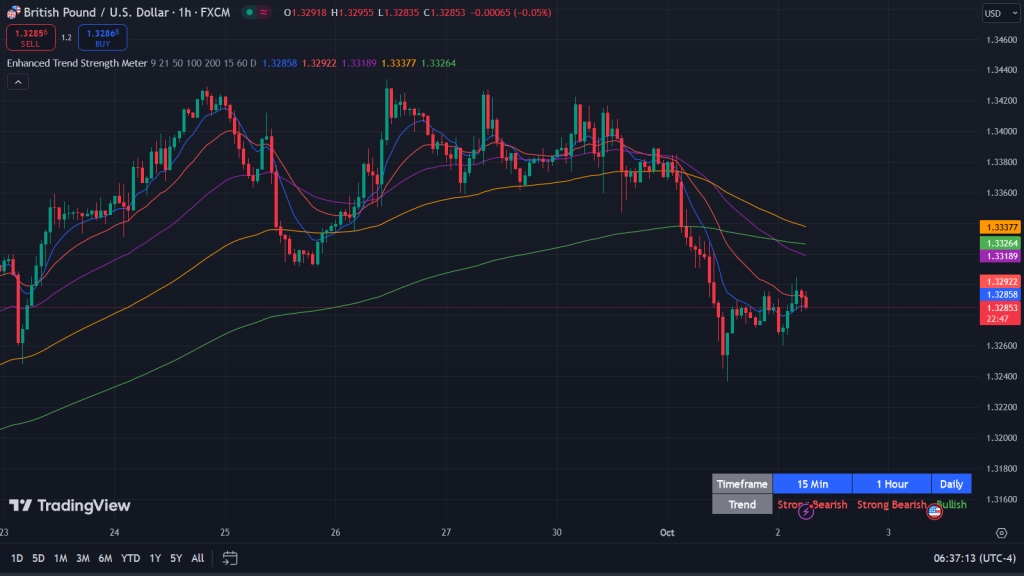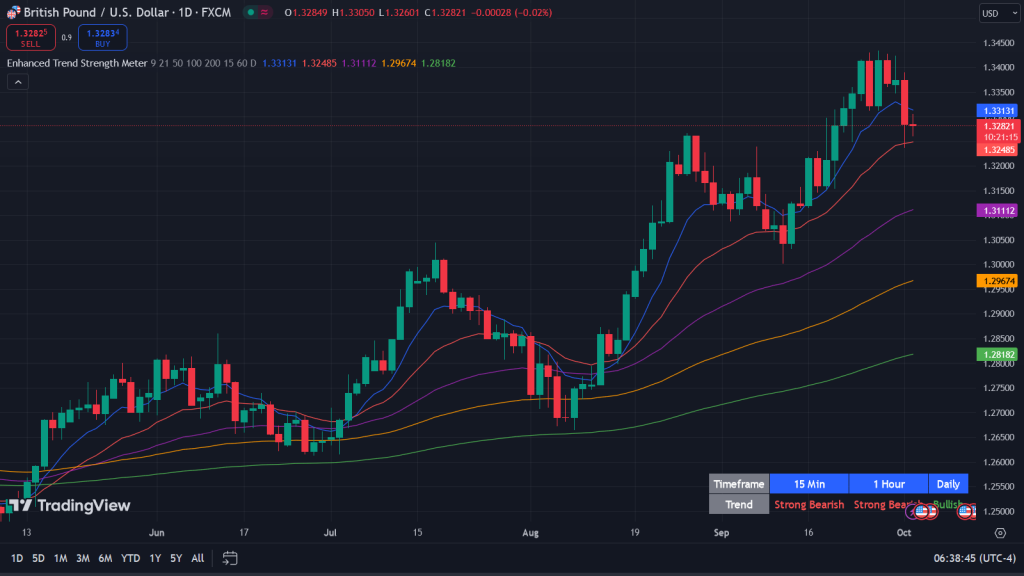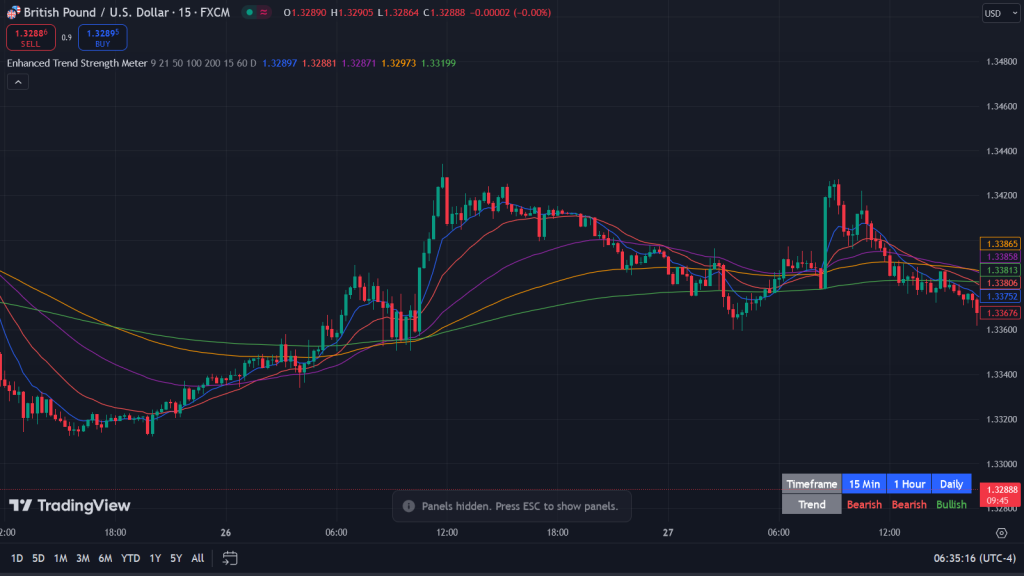🔓 Get All Tools for FREE!
- ✅ Click here to open a trading account using our referral link and start trading.
- 📅 After 7 days of active trading under our referral link, you can get access to all tools in your account.
- ⚠️ Keep trading to keep access free — if you're inactive for 7 days, your access will be removed.
- 👉 Already have an account? You can change the IB (introducing broker) to our referral link ( https://one.exnesstrack.org/a/w7syl3vnjb ) and still qualify!
In today’s fast-paced trading world, making informed decisions is the key to consistent success. One of the biggest challenges for traders is assessing the strength of a trend. Whether you’re new to trading or an experienced trader, the ability to accurately gauge trend strength can significantly impact your profits. Enter the Trend Strength Meter—a powerful TradingView indicator designed to take the guesswork out of trend analysis. In this comprehensive guide, we’ll explore what the Trend Strength Meter is, how it works, and why it’s a game-changer for traders.
What is the Trend Strength Meter?
The Trend Strength Meter is a specialized indicator available on TradingView, one of the most popular charting platforms for traders. Indicators are tools that help traders analyze market data, identify patterns, and make decisions based on technical analysis. The Trend Strength Meter specifically focuses on the strength of a trend, offering valuable insights for traders who want to capitalize on trends or avoid weak markets.
This indicator uses a series of Exponential Moving Average (EMA) filters to calculate the momentum of price action in the market. The stronger the trend, the more confident a trader can be in placing trades. On the flip side, if the trend is weak, it may signal potential reversals or consolidation periods, where making a trade could be riskier. The Trend Strength Meter eliminates the need for subjective guesswork, giving you a reliable tool to enhance your trading strategy.
🔓 Get All Tools for FREE!
- ✅ Click here to open a trading account using our referral link and start trading.
- 📅 After 7 days of active trading under our referral link, you can get access to all tools in your account.
- ⚠️ Keep trading to keep access free — if you're inactive for 7 days, your access will be removed.
- 👉 Already have an account? You can change the IB (introducing broker) to our referral link ( https://one.exnesstrack.org/a/w7syl3vnjb ) and still qualify!

How Does the Trend Strength Meter Work?
The Trend Strength Meter operates by using Exponential Moving Averages (EMAs), which are a type of moving average that gives more weight to recent price data. This allows it to react more quickly to changes in the market compared to other moving averages like the Simple Moving Average (SMA). Here’s how it works:
- EMA Filters: The core of the Trend Strength Meter lies in its use of EMA filters. By analyzing price data across multiple timeframes using these filters, the indicator can determine whether a trend is gaining strength or weakening. Strong trends are typically supported by an increasing EMA, while weakening trends will show a flattening or declining EMA.
- Real-Time Updates: The indicator continuously updates its calculations in real-time, offering traders instant feedback on the current state of the trend. This is particularly useful for swing traders, day traders, or scalpers who need to make decisions quickly based on up-to-the-minute data.
- Custom Alerts: One of the most convenient features of the Trend Strength Meter is its ability to set custom alerts. Traders can define specific trend strength levels, and the indicator will send a notification when those thresholds are reached. This allows traders to stay informed without having to constantly monitor the charts.
- Visual Display: The Trend Strength Meter features an easy-to-read, visual meter on the chart. It provides a simple representation of the trend’s strength—ranging from weak to strong—so traders can make faster, more informed decisions at a glance. This visual element simplifies trend analysis, making it easier for traders to spot opportunities or risks.
Why the Trend Strength Meter is a Must-Have for Traders
1. Removes Guesswork from Trend Analysis
One of the biggest hurdles for traders is understanding the true strength of a trend. Even experienced traders can find it difficult to determine whether a trend is strong enough to warrant entry, or if it’s losing steam and about to reverse. The Trend Strength Meter removes this uncertainty by providing a clear, data-driven metric of trend strength, allowing traders to make informed decisions with confidence.
2. Improves Entry and Exit Points
A strong trend often signals an optimal entry point for a trade, while a weakening trend may indicate it’s time to exit. By using the Trend Strength Meter, traders can optimize their entry and exit points, ensuring they ride the strongest part of a trend and avoid getting caught in consolidations or reversals. This can lead to better trade outcomes and more consistent profitability over time.
3. Works Across Multiple Timeframes
The Trend Strength Meter is versatile enough to work across different timeframes, making it ideal for both short-term and long-term traders. Whether you’re a scalper looking for quick intraday movements, a swing trader holding positions for days, or a long-term investor, this indicator provides valuable insights at any timeframe. You can even apply it to multiple timeframes simultaneously for a more comprehensive view of market conditions.
4. Real-Time Market Adaptation
In fast-moving markets, outdated information can cost you a trade. The Trend Strength Meter’s real-time updates ensure that you’re always working with the most current data. This feature is particularly helpful for day traders who rely on fast, accurate information to make quick decisions. With this indicator, traders can quickly react to changing market conditions and seize opportunities as they arise.
5. Compatible with Different Trading Strategies
The Trend Strength Meter isn’t limited to one particular trading style. Whether you’re trading stocks, forex, crypto, or commodities, this indicator can be easily incorporated into your existing strategy. For example, trend-following traders can use it to confirm a trend before entering, while contrarian traders can use it to identify potential reversal points.
6. Enhances Risk Management
By providing insight into the strength of a trend, the Trend Strength Meter helps traders improve their risk management. Knowing the strength of a trend allows traders to adjust their stop-loss and take-profit levels more accurately. In a strong trend, traders can widen their take-profit targets, while in a weak trend, they can tighten their stop-losses to avoid unnecessary risk.
How to Use the Trend Strength Meter on TradingView
Here’s a step-by-step guide on how to apply the Trend Strength Meter on your TradingView chart:
- Install the Indicator: Go to TradingView’s indicator library and search for the “Trend Strength Meter” in the community scripts section. Once you find it, click “Add to Chart.”
- Select Your Timeframe: Adjust the chart’s timeframe based on your trading style. You can use it on any timeframe, from 1-minute to daily charts, depending on your strategy.
- Interpret the Meter: The meter on the chart will display the current trend strength. A high reading indicates a strong trend, while a lower reading suggests weakening momentum or a sideways market.
- Set Custom Alerts: If you want to be notified when the trend strength reaches a specific level, you can set custom alerts through TradingView. This ensures you’ll never miss an important move in the market.
- Combine with Other Indicators: For best results, use the Trend Strength Meter in combination with other indicators like RSI, MACD, or support and resistance levels to further refine your trading decisions.

Pinescript code of "Enhanced Trend Strength Meter"
//@version=5
// insta id algo_aakash
indicator("Enhanced Trend Strength Meter", overlay=true)
// Inputs for the EMA lengths
ema1Len = input.int(9, title="EMA 1 Length", minval=1)
ema2Len = input.int(21, title="EMA 2 Length", minval=1)
ema3Len = input.int(50, title="EMA 3 Length", minval=1)
ema4Len = input.int(100, title="EMA 4 Length", minval=1)
ema5Len = input.int(200, title="EMA 5 Length", minval=1)
// Timeframes for multi-timeframe analysis
tf1 = input.timeframe("15", title="Timeframe 1 (15 Min)")
tf2 = input.timeframe("60", title="Timeframe 2 (1 Hour)")
tf3 = input.timeframe("D", title="Timeframe 3 (Daily)")
// EMA calculations for the current chart timeframe
ema1 = ta.ema(close, ema1Len)
ema2 = ta.ema(close, ema2Len)
ema3 = ta.ema(close, ema3Len)
ema4 = ta.ema(close, ema4Len)
ema5 = ta.ema(close, ema5Len)
plot(ema1,"EMA 1",color.blue)
plot(ema2,"EMA 2",color.red)
plot(ema3,"EMA 3",color.purple)
plot(ema4,"EMA 4",color.orange)
plot(ema5,"EMA 5",color.green)
// Function to determine trend strength based on EMAs
trendStrength(ema1, ema2, ema3, ema4, ema5) =>
// Count how many EMAs are below the price
countUptrend = (close > ema1 ? 1 : 0) + (close > ema2 ? 1 : 0) + (close > ema3 ? 1 : 0) + (close > ema4 ? 1 : 0) + (close > ema5 ? 1 : 0)
// Determine trend based on count of uptrend EMAs
countUptrend == 5 ? "Strong Bullish" : countUptrend >= 3 ? "Bullish" : countUptrend == 0 ? "Strong Bearish" : "Bearish"
// Trend strength on multiple timeframes
trend1 = request.security(syminfo.tickerid, tf1, trendStrength(ta.ema(close, ema1Len), ta.ema(close, ema2Len), ta.ema(close, ema3Len), ta.ema(close, ema4Len), ta.ema(close, ema5Len)))
trend2 = request.security(syminfo.tickerid, tf2, trendStrength(ta.ema(close, ema1Len), ta.ema(close, ema2Len), ta.ema(close, ema3Len), ta.ema(close, ema4Len), ta.ema(close, ema5Len)))
trend3 = request.security(syminfo.tickerid, tf3, trendStrength(ta.ema(close, ema1Len), ta.ema(close, ema2Len), ta.ema(close, ema3Len), ta.ema(close, ema4Len), ta.ema(close, ema5Len)))
// Plotting table with the trend status
var table trendTable = table.new(position.bottom_right, 4, 2, border_width=1, frame_color=color.gray)
if (bar_index == 0)
table.cell(trendTable, 0, 0, "Timeframe", bgcolor=color.gray, text_color=color.white)
table.cell(trendTable, 0, 1, "Trend", bgcolor=color.gray, text_color=color.white)
table.cell(trendTable, 1, 0, "15 Min", bgcolor=color.blue, text_color=color.white)
table.cell(trendTable, 2, 0, "1 Hour", bgcolor=color.blue, text_color=color.white)
table.cell(trendTable, 3, 0, "Daily", bgcolor=color.blue, text_color=color.white)
// Update the table with trend direction
table.cell(trendTable, 1, 1, trend1, text_color=(trend1 == "Bullish" or trend1 == "Strong Bullish" ? color.green : color.red))
table.cell(trendTable, 2, 1, trend2, text_color=(trend2 == "Bullish" or trend2 == "Strong Bullish" ? color.green : color.red))
table.cell(trendTable, 3, 1, trend3, text_color=(trend3 == "Bullish" or trend3 == "Strong Bullish" ? color.green : color.red))
// Optional: Visualize trend strength on chart
// plotshape(trend1 == "Strong Bullish", title="15 Min Strong Bullish", location=location.belowbar, color=color.green, style=shape.labelup, text="15M Strong Bullish", size=size.small)
// plotshape(trend1 == "Bullish", title="15 Min Bullish", location=location.belowbar, color=color.lime, style=shape.labelup, text="15M Bullish", size=size.small)
// plotshape(trend1 == "Bearish", title="15 Min Bearish", location=location.abovebar, color=color.orange, style=shape.labeldown, text="15M Bearish", size=size.small)
// plotshape(trend1 == "Strong Bearish", title="15 Min Strong Bearish", location=location.abovebar, color=color.red, style=shape.labeldown, text="15M Strong Bearish", size=size.small)
// Repeat for other timeframes as needed

Conclusion
The Trend Strength Meter is a powerful, versatile indicator that can help traders of all levels improve their trend analysis. By using EMA filters and real-time data, it eliminates the guesswork from trading, allowing you to confidently make better trading decisions. Whether you’re looking to improve your entry and exit points, manage risk, or simply get a clearer picture of market conditions, the Trend Strength Meter is a must-have tool for your TradingView setup.
Disclaimer:
The content in this post is for informational and educational purposes only and does not constitute financial or trading advice. Trading and investing in financial markets, including stocks, forex, cryptocurrencies, and commodities, involves risk, and you should be aware of these risks before engaging in any trading activities. Past performance of indicators or strategies is not indicative of future results. Always conduct your own research, consult with a qualified financial advisor, and use proper risk management before making any trading or investment decisions. The Trend Strength Meter and other tools mentioned here are meant to assist in analysis, but they do not guarantee success in the markets.

0 Comments